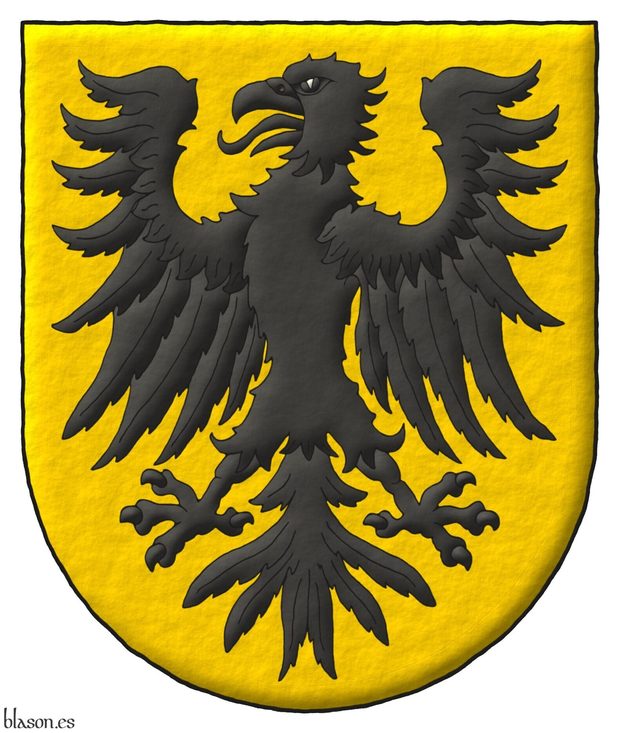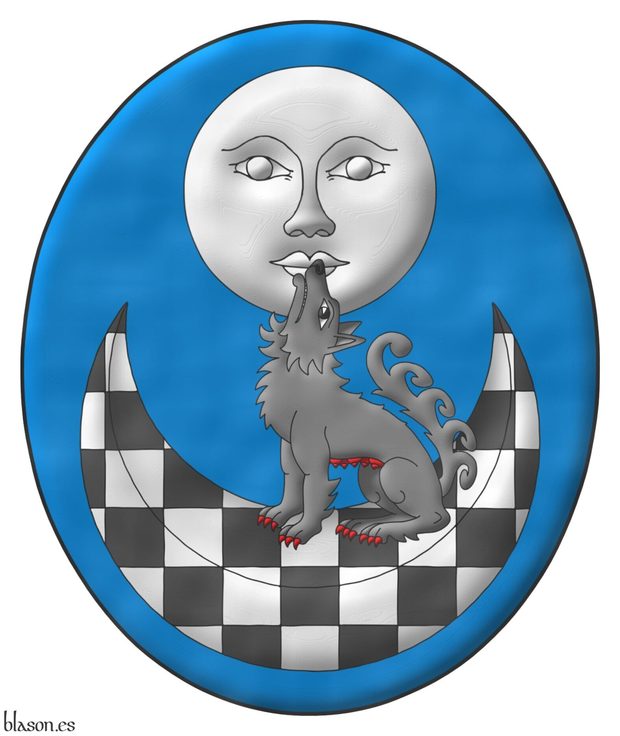
Arrano Beltza, plain tincture

Or, a eagle displayed Sable.
Arms painted by me, in plain tinctures, contoured in Sable, with a semi-circular external shape and with a texturized finish.
Coat of arms of the Arrano Beltza, the black eagle, emblazoned by me. Historically, it is associated with the Kingdom of Navarre and its king, Sancho VII the Strong, 1154-1234, although there is no definitive documentary evidence that it was used as an official coat of arms.
Blazon keywords: Or, Sable, One, Eagle and Displayed.
Style keywords: Outlined in sable, Plain tincture and Semi-circular.
Classification: Civic, Interpreted, Boa and Coat of arms.
Bearer: Arrano Beltza.


Arrano Beltza

Or, a eagle displayed Sable.
Escudo de oro, un águila de sable.
Arms painted by me, illuminated with lights and shadows, contoured in Sable, and with a freehand finish.
Coat of arms of the Arrano Beltza, the black eagle in Basque, emblazoned by me.
Blazon keywords: Or, Sable, One, Eagle and Displayed.
Style keywords: Outlined in sable, Illuminated and Freehand.
Classification: Civic, Interpreted, Boa and Coat of arms.
Bearer: Arrano Beltza.


![Ver [Merrigan, M.; 2024] en referencias bibliográficas. Libro abierto, hojas de plata, filo de oro, guardas de gules, tapas de sable.](../css/Libro.Bibliografia.png)
Merrigan, M.; 2024
Michael Merrigan, MA, FGSI, «Heraldry and Marriage Equality», Annual Journal of the Genealogical Society of Ireland, volume 25, pages 157 to 164 ISSN 2712-0228, familyhistory.ie, Published by the Genealogical Society of Ireland, Dublin, December of 2019.
The 2024 Annual Journal of the Genealogical Society of Ireland has been published, spanning 186 pages, familyhistory.ie. This Annual Journal has been delivered to all members and deposited in the Copyright Libraries across Ireland and the United Kingdom.
It includes the article «Heraldry and Marriage Equality» by Michael Merrigan, MA, FGSI, on pages 157 to 164, where, alongside Martin Goldstraw, JP, FRSA, I have had the honor of being cited, along with 2 coats of arms designed by me.
Bibliographical reference of century XXI.
Classification: Article, English language and Black and white and color illustrations.
The author is Merrigan, Michael.
External resource:
Internal resources: 20241202.JournalGenealogicalSocietyIreland.2024.pdf Annual Journal and 20241202.JournalGenealogicalSocietyIreland.2024.pag.157.164.pdf Article.


Teresa Otxoa Magaña, schema 1x3
Azure, in chief a moon with human face Argent, in base a crescent chequey Sable and Argent; overall a she-wolf ululant, sejant on the crescent proper, armed and the udders Gules.
The coat of arms of Teresa Otxoa Magaña designed by her and her husband Juan Lanzagorta Vallín, and emblazoned by me with an oval shape in 3 steps: ratios, outlined, and tinctures.
Blazon keywords: Azure, Argent, Sable, Gules, One, Chief, Moon, With human face, Base, Crescent, Chequey, Overall, She-wolf, Ululant, Sejant, Proper, Armed and Udder.
Style keywords: Ratio, Outlined, Outlined in sable, Plain tincture and Oval.
Classification: Personal, Interpreted, Schema, Boa and Coat of arms.
Bearer: Otxoa Magaña, Teresa.


Teresa Otxoa Magaña, outlined

Azure, in chief a moon with human face Argent, in base a crescent chequey Sable and Argent; overall a she-wolf ululant, sejant on the crescent proper, armed and the udders Gules.
The coat of arms of Teresa Otxoa Magaña designed by her and her husband Juan Lanzagorta Vallín, and outlined by me.
Blazon keywords: Azure, Argent, Sable, Gules, One, Chief, Moon, With human face, Base, Crescent, Chequey, Overall, She-wolf, Ululant, Sejant, Proper, Armed and Udder.
Style keywords: Outlined, Outlined in sable and Oval.
Classification: Personal, Interpreted, Boa and Coat of arms.
Bearer: Otxoa Magaña, Teresa.


Teresa Otxoa Magaña, plain tincture

Azure, in chief a moon with human face Argent, in base a crescent chequey Sable and Argent; overall a she-wolf ululant, sejant on the crescent proper, armed and the udders Gules.
Arms emblazoned by me, in plain tinctures, outlined in Sable, with an oval external shape and with a texturized finish.
The coat of arms of Teresa Otxoa Magaña designed by her and her husband Juan Lanzagorta Vallín, and emblazoned by me. Blazon written in Italian by Vittorio Gifra, «Arma: d'azzurro, alla luna figurata d'argento posta in capo, accompanata in punta da un crescente montante scaccato di nero e d'argento; alla lupa di nero sul tutto, seduta su esso crescente, armata e mammellata di rosso».
Blazon keywords: Azure, Argent, Sable, Gules, One, Chief, Moon, With human face, Base, Crescent, Chequey, Overall, She-wolf, Ululant, Sejant, Proper, Armed and Udder.
Style keywords: Outlined in sable, Plain tincture and Oval.
Classification: Personal, Interpreted, Boa and Coat of arms.
Bearer: Otxoa Magaña, Teresa.


Otxoa Magaña, Teresa

Azure, in chief a moon with human face Argent, in base a crescent chequey Sable and Argent; overall a she-wolf ululant, sejant on the crescent proper, armed and the udders Gules.
Escudo de azur, en jefe una luna figurada de plata, en punta un creciente ajedrezado de sable y plata; brochante sobre el todo una loba aullante, sentada en el creciente al natural, armada y ubres de gules.
Coat of arms emblazoned by me, highlighted with lights and shadows, outlined in Sable, with an oval external shape and with a watercolor finish.
The coat of arms of Teresa Otxoa Magaña designed by her and her husband Juan Lanzagorta Vallín, and emblazoned by me. The primitive arms of the Otxoa lineage feature wolves, as the name derives from the Basque word «otso» meaning wolf and she-wolf, therefore, both the arms of the lineage and hers are «canting arms», though hers specifically feature a she-wolf.
Blazon keywords: Azure, Argent, Sable, Gules, One, Chief, Moon, With human face, Base, Crescent, Chequey, Overall, She-wolf, Ululant, Sejant, Proper, Armed and Udder.
Style keywords: Outlined in sable, Illuminated, Oval and Watercolor.
Classification: Personal, Interpreted, Boa and Coat of arms.
Bearer: Otxoa Magaña, Teresa.


Motto around the shield of Teresa Otxoa Magaña

Azure, in chief a moon with human face Argent, in base a crescent chequey Sable and Argent; overall a she-wolf ululant, sejant on the crescent proper, armed and the udders Gules. Motto around the shield: «Linaje Lanzagorta Otxoa · Bizkaia · México» Sable over a scroll Argent.
Arms depicted by me, in plain tinctures, outlined in Sable, with an oval outer contour and with a texturized finish.
The coat of arms of Teresa Otxoa Magaña designed by her and her husband Juan Lanzagorta Vallín, and emblazoned by me.
Blazon keywords: Azure, Argent, Sable, Gules, One, Chief, Moon, With human face, Base, Crescent, Chequey, Overall, She-wolf, Ululant, Sejant, Proper, Armed, Udder, Within, Motto (identification) and Scroll.
Style keywords: Outlined in sable, Plain tincture and Oval.
Classification: Personal, Interpreted, Boa and Coat of arms.
Bearer: Otxoa Magaña, Teresa.

Continue with: Design with a fess between 4 water-bougets.
-
Language
-
Categories of heraldry
-
Divisions of the field
- Without divisions
- Party per pale
- Party per fess
- Party per bend
- Party per bend sinister
- Tierce
- Tierce sinister
- Tierced per pale
- Tierced per fess
- Tierced per bend
- Tierced pallwise inverted
- Quarterly
- Quarterly per saltire
- Gyronny
- Party per fess, the chief per pale
- Party per pale, the sinister per fess
- Party per fess, the base per pale
- Party per pale, the dexter per fess
- Chapé
- Chaussé
- Embrassé
- Contre-embrassé
- Party per chevron
- Enté
- Enté en point
- Flanched
-
Metals
-
Colours
-
Furs
-
Other tinctures
-
Ordinaries and sub-ordinaries
-
Diminutives of the ordinaries
-
Geometric charges
-
Composite ordinaries
-
Inanimate charges from Nature
Atom, Crescent, Diamond, Emerald, Estoile, Increscent, Lightning flash, Moon, Mount, Mullet, Mullet of four points, Orbital, Plough of Ursa Major, Rainbow, Ray of the sun, River, Sea, Snowflake, Sun, Sun in splendour, Sun of May, Trimount, Water and Wave.
-
Vegetal charges from Nature
Acorn, Apple, Apple tree, Ash, Bluebonnet, Camellia, Chrysanthemum, Cinquefoil, Cornflower, Dogwood flower, Double rose, Elm, Fleur de lis, Flower, Gourd, Holm oak, Hop cone, Kapok tree, Laurel, Lily, Linden, Lotus flower, Madonna lily, Mexican cedar tree, Oak, Olive tree, Palm tree, Plantain plant, Pomegranate, Poplar leaf, Rose, Shamrock, Sunflower, Thistle, Tree, Tulip, Vine and Wheat.
-
Animal charges from Nature
Badger, Bald eagle, Barbel, Barn owl, Bear, Beaver, Beetle, Bighorn sheep, Blackbird, Boar, Brach hound, Bull, Doe, Dog, Dolphin, Dove, Eagle, Elephant, Falcon, Female figure, Fish, Flame, Fly, Fox, Frog, Goat, Goldfinch, Goose, Heron, Horse, Hummingbird, Jaguar, Lark, Leopard, Lion, Lion passant, Lion rampant guardant, Lioness, Lynx, Male figure, Martlet, Merino ram, Owl, Panther, Parrot, Peacock, Pelican, Pelican in her piety, Puffin, Quetzal, Raven, Roe deer, Rooster, Savage, Seagull, Serpent, She-wolf, Stag, Starling, Talbot, Tyger, Vulture, Warren hound and Wolf.
-
Parts of natural charges
Arm, Beak, Branch, Caboshed, Chest, Claw, Covert, Dorsal fin, Eagle claw, Ermine spot, Escallop, Feather, Foot (palmiped), Foreleg, Forepaw, Hand, Head, Heart, Hoof, Leaf, Neck, Ostrich feather, Palm frond, Paw, Roe deers' attires, Shoulder, Sprig, Stags' attires, Stem, Swallow-tail, Tail, Tail addorsed, Tail fin, Talon, Tooth, Trunk, Trunk (elephant), Two hands clasped, Two wings in vol, Udder, Wheat spike, Wing and Wrist.
-
Artificial charges
Ace of spades, Anchor, Anvil, Arch, Arm vambraced, Armillary sphere, Arrow, Axe, Bell, Bell tower, Beret, Bonfire, Book, Bookmark, Bow, Branding iron, Bridge, Broken, Buckle, Cannon, Cannon dismounted, Cannon port, Canopy roof, Carbuncle, Castle, Celtic Trinity knot, Chain, Chess rooks, Church, Clarion, Clay pot, Closed book, Club, Column, Comb, Compass rose, Conductor's baton, Cord, Covered cup, Crozier, Crucible, Cuffed, Cup, Cyclamor, Dagger, Double vajra, Drum, Ecclesiastical cap, Fanon, Federschwert, Fleam, Four crescents joined millsailwise, Galician granary, Garb, Gauntlet, Geometric solid, Grenade, Halberd, Hammer, Harp, Host, Hourglass, Key, Key ward, Knight, Knot, Lantern, Letter, Line, Loincloth, Menorah, Millrind, Millstone, Millwheel, Monstrance, Mortar, Mullet of six points pierced, Nail, Non-classic artifact, Norman ship, Number, Oar, Oil lamp, Open book, Page, Pair of scales, Parchment, Pestle, Piano, Pilgrim's staff, Plough share, Polish winged hussar, Port, Portcullis, Potent, Quill, Ribbon, Rosette of acanthus leaves, Sabre, Sackbut, Sail, Scroll, Scythe, Sheaf of tobacco, Ship, Skirt, Spear, Spear's head, Stairway, Star of David, Step, Sword, Symbol, Tetrahedron, Torch, Tower, Trident, Trumpet, Turret, Two-handed sword, Wagon-wheel, Water-bouget, Wheel, Winnowing fan and With a turret.
-
Immaterial charges
Angel, Archangel, Basilisk, Dragon, Dragon's head, Garuda, Golden fleece, Griffin, Heart enflamed, Justice, Mermaid, Our Lady of Mercy, Ouroboros, Paschal lamb, Pegasus, Phoenix, Sacred Heart of Jesus, Saint George, Sea-griffin, Trinity, Triton, Unicorn, Winged hand and Wyvern.
-
External elements
-
Heraldic creations
-
References
-
Formats
-
Keywords on this page
Between, Watercolor, Chequey, Proper, Armed, Arrano Beltza, Article, Ululant, Azure, Bibliography, Boa, Overall, Base, Crescent, Four, Outlined, Outlined in sable, Within, Displayed, Motto (identification), Doctor, Two, Black and white and color illustrations, In chief, In base, Coat of arms, Schema, With human face, Personal, Gules, Illuminated, Interpreted, Chief, She-wolf, Moon, Semi-circular, Or, Otxoa Magaña, Teresa, Oval, Argent, Civic, Ratio, Sable, Sejant, Plain tincture, Freehand, Udder, One and Eagle.


